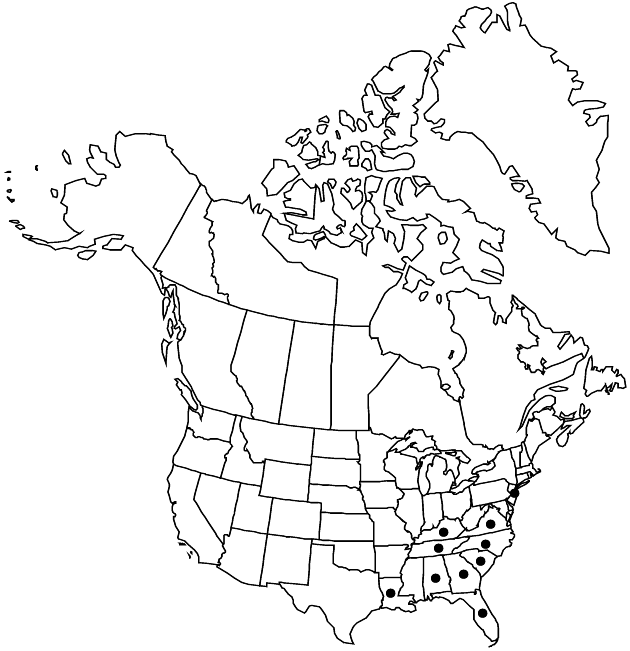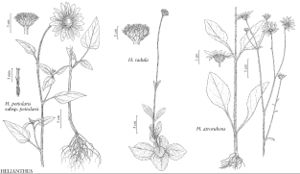Difference between revisions of "Helianthus atrorubens"
Sp. Pl. 2: 906. 1753.
FNA>Volume Importer |
imported>Volume Importer |
||
| (One intermediate revision by the same user not shown) | |||
| Line 8: | Line 8: | ||
}} | }} | ||
|common_names=Purpledisc sunflower | |common_names=Purpledisc sunflower | ||
| + | |special_status={{Treatment/ID/Special_status | ||
| + | |code=F | ||
| + | |label=Illustrated | ||
| + | }}{{Treatment/ID/Special_status | ||
| + | |code=E | ||
| + | |label=Endemic | ||
| + | }} | ||
|basionyms= | |basionyms= | ||
|synonyms={{Treatment/ID/Synonym | |synonyms={{Treatment/ID/Synonym | ||
| Line 54: | Line 61: | ||
|publication title=Sp. Pl. | |publication title=Sp. Pl. | ||
|publication year=1753 | |publication year=1753 | ||
| − | |special status= | + | |special status=Illustrated;Endemic |
| − | |source xml=https:// | + | |source xml=https://bitbucket.org/aafc-mbb/fna-data-curation/src/2e0870ddd59836b60bcf96646a41e87ea5a5943a/coarse_grained_fna_xml/V19-20-21/V21_372.xml |
|tribe=Asteraceae tribe Heliantheae | |tribe=Asteraceae tribe Heliantheae | ||
|subtribe=Asteraceae (tribe Heliantheae) subtribe Helianthinae | |subtribe=Asteraceae (tribe Heliantheae) subtribe Helianthinae | ||
Latest revision as of 20:11, 5 November 2020
Perennials, 50–200 cm (with crown buds; nonflowering stems usually absent). Stems erect, proximally villous to strigoso-hispid, distally hispid or glabrate. Leaves mostly basal; opposite; petioles 4–25 cm (usually winged at least 1/2 their lengths); blades lanceolate to ovate, 7–26 × 3–10 cm, bases broadly cuneate to nearly truncate (often decurrent onto petioles), margins serrate to crenate, abaxial faces strigoso-hispid (hairs of midribs1+ mm), not gland-dotted (cauline to 8 pairs proximal to heads, ovate to elliptic, smaller). Heads (1–)3–15+. Peduncles 0.3–17 cm. Involucres broadly hemispheric, 9–16 mm diam. Phyllaries 15–22, broadly ovate to oblong, 7–9 × 4–5 mm, (margins ciliolate) apices obtuse to acute, sometimes mucronate, abaxial faces usually glabrous. Paleae 4–5.5 mm, ± 3-toothed to entire. Ray florets 10–15; laminae 15–22 mm (abaxial faces not gland-dotted). Disc florets 75+; corollas 4–6 mm, lobes reddish; anthers dark, appendages dark (style branches yellow). Cypselae 2.8–3 mm, glabrous or distally puberulent; pappi of 2 aristate scales 2.5–2.8 mm. 2n = 34.
Phenology: Flowering late summer–fall.
Habitat: Open mixed woods, roadsides
Elevation: 0–900 m
Distribution

Ala., Fla., Ga., Ky., La., N.J., N.C., S.C., Tenn., Va.
Discussion
Helianthus atrorubens and H. silphioides form a morphologically similar pair of species that share the distinctive feature of relatively broad, tightly appressed phyllaries with apices obtuse to acute. Helianthus atrorubens has a more easterly geographic distribution along the Piedmont and the Atlantic coastal plain and the southern Appalachian Mountains; distribution of H. silphioides is centered in the Ozark region. In general, H. silphioides differs in its usually well developed cauline leaves, and basal leaves with winged petioles that are less than half the total lengths. Involucres with phyllaries tightly appressed are also observed in H. occidentalis and H. pauciflorus subsp. pauciflorus, which differs in having the phyllary apices acute to acuminate as well as in usually having abaxial faces of leaves and ray laminae densely gland-dotted.
Selected References
None.
